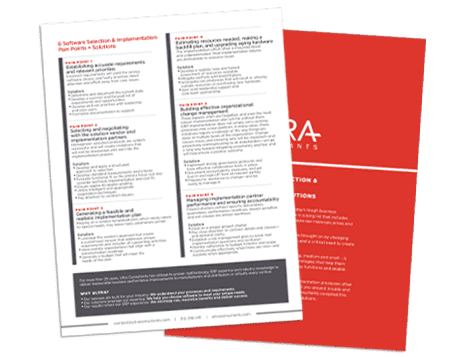Buying an ERP system? Many manufacturing and distribution organization project teams are now considering an active ERP project.
The reasons vary, but in all, it’s likely that legacy technologies and processes are not robust enough to manage costs, streamline operations and accommodate growth.

The Reasons for Buying an ERP System
When project teams consider the capabilities of today’s modern ERP software, they are wise to take a close look at whether their organizations are experiencing diminishing benefits from their legacy systems.
- The ERP software may be a victim of end-of-life “sunsetting” where support is discontinued. Another possible scenario involves the vendor putting the product in “maintenance mode” with limited updates.
- These legacy ERP software packages may no longer address the critical needs of today’s organization in areas of reporting, planning or overall efficiency.
- Scale is also an issue. Many teams realize they can’t scale their operations due to a legacy ERP system developed more than a decade ago. Leadership might be planning for aggressive expansion to meet the region’s expansion into new markets and distribution channels, but often finds that an outdated system and standalone spreadsheets currently used to run the company can’t scale.
- Organizations depending on legacy products are also limited due to a lack of mobile functionality, analytics, CRM, and other applications that are needed in today’s competitive environment
As independent ERP consultants, we’ve seen many of these scenarios in play. Based on this experience, offered here are high-level pointers to keep in mind as you start the ERP journey.
3 Pointers When Buying an ERP System
Pointer #1: Focus on People and Processes, not Just Technology
Successful ERP projects require that the most important work is done before the selection begins. It’s so much more than just dropping in a new piece of software.
For an effective approach, remember preparation starts at the top, as we describe in a blog post, 10 Questions: Does Your Company Need a New ERP? And Is It Ready to Do It Successfully? C-Level support and buy-in are essential and the lack of it is indeed a deal-breaker. Other steps include developing a phased strategy and defining the project team. This is also the time to identify holes, inefficiencies, and roadblocks in current business processes.
We have the data to confirm that a focus on people and processes is the way to go.
Mint Jutras conducted a survey of mid-market manufacturers and distributors for Ultra Consultants, focusing on the success of their ERP implementations in terms of schedule, cost and return on investment (ROI).
The survey reviewed goals and expectations, whether or not they were achieved, and why.
- The Mint Jutras/Ultra Consultants survey found that the primary reasons for success had to do with people and process, and not just software. Key success factors include top management support and change management.
- Reasons for lack of implementation success include inadequate business process re-engineering and inadequate project planning.
- While many ERP implementations meet expectations in terms of schedule, budget and ROI, the Mint Jutras/Ultra Consultants study shows a significant number of manufacturing and distribution companies’ over-rate their success and leave additional attainable returns on the table.
So again, putting people and processes first is the best step when the team is on the road to buying a new ERP system.
Pointer #2: Assess the Risks
Selecting and implementing a new ERP system is likely one of the most complex and resource-intensive initiatives a company will ever face.
Consider the areas of risk that are inherent in such an effort by assessing and managing the most pervasive risks related to cost overruns, project delays, and other issues. Typical in-house resources don’t have extensive experience in assessing these risks and therefore, find themselves reacting to risks and issues after they surface which leads to problems in achieving expectations.
Why devote careful analysis to the many categories of risk that come with enterprise software selection and implementation? Gaining an awareness of ERP risk categories will help teams take steps to address potential issues.
Pointer #3: Make Comprehensive Planning a Priority
Ultra has found successful ERP projects invest more energy in understanding their business well in the preparation phase than they spend in the selection process.
This phase includes a comprehensive analysis of current processes and a definition of future processes. Moreover, it identifies opportunities for change and outlines the necessary change management to achieve business value.
Rather than having a focus on converting the current state to a new ERP system, the project focus should be to use technology to drive business value improvement. We’ve found that failing to fully understand and document the current state and the desired future state is the single biggest reason ERP projects fail.
Preparation also includes an educational component to review current best practices and revise move to the desired future state. The detailed business process review necessary to craft the future state is often the hardest step in ERP projects.
Understanding this blind spot is the key to success when buying a new ERP system. Winning teams use a proven methodology with a team of highly experienced manufacturing and distribution experts to ensure that the project emphasize is on preparation over selection.
Final Thoughts for Teams Buying an ERP System
As your team considers buying an ERP system, consider how your enterprise can benefit from working with expert ERP selection consultants. Ultra’s team of consultants brings decades of experience in enterprise software systems and best business practices for the manufacturing and distribution industries.
We’ll leave you with this last reminder: be sure you take time to define the right processes, ensuring they are effectively used throughout the enterprise and avoiding common pitfalls throughout the preparation, ERP selection and implementation.
Contact Ultra for insight on what it takes when buying an ERP system.

6 Software Selection & Implementation Pain Points + Solutions
Software selection and implementation processes often present challenges of their own. To steer you around trouble and help you drive success, Ultra’s experts compiled a list of pain points and solutions to be aware of as you embark on this journey.
Table of Contents
More ERP material...
Choosing a CRM System for Your Business
Data analytics holds the ability to highlight inefficient manufacturing processes and enable…
The Undeniable Benefits of Implementing ERP in Food and Beverage Manufacturing
Data analytics holds the ability to highlight inefficient manufacturing processes and enable…
Emerging Technologies in Manufacturing Driving Business Growth
Data analytics holds the ability to highlight inefficient manufacturing processes and enable…



